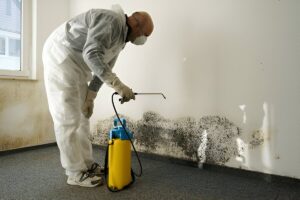Mold can be a troublesome issue for homeowners, causing not only unsightly patches on walls and ceilings but also potential health risks. To effectively manage mold growth, it is essential to identify and address the underlying sources of moisture that facilitate its proliferation. This comprehensive guide delves into moisture leak detection, providing a structured approach to finding and eliminating the sources of mold in your home.
Understanding Mold and Its Requirements
Mold is a type of fungus that thrives in damp environments. For it to flourish, three key elements are necessary: moisture, warmth, and organic material. Understanding these requirements can help homeowners pinpoint potential mold growth areas in their residences.
The Role of Moisture
Moisture is the primary catalyst for mold growth. It can originate from various sources, including:
- Water leaks: Leaking pipes, roofs, or appliances
- Humidity: High humidity levels can result from inadequate ventilation
- Condensation: Occurs when warm air meets cold surfaces
Temperature and Organic Material
Mold prefers warm environments, typically between 60°F and 80°F (15°C to 27°C). Additionally, it feeds on organic materials, which can be found in:
- Wood
- Drywall
- Carpet
- Insulation
By understanding these factors, homeowners can better assess their living spaces for potential mold growth.
Common Sources of Moisture Leaks
Identifying moisture sources is crucial in preventing mold infestations. Here are some common culprits:
Plumbing Issues
Water leaks from plumbing fixtures are a frequent source of moisture. Homeowners should regularly inspect:
- Faucets
- Toilets
- Pipes
Even small leaks can create a damp environment conducive to mold growth.
Roof and Attic Problems
A compromised roof can lead to water intrusion, especially during heavy rainfall. Homeowners should check for:
- Missing or damaged shingles
- Cracks in flashing
- Poorly sealed vents
Foundation and Basement Concerns
Basements and crawl spaces are often prone to moisture issues. Inspect these areas for:
- Cracks in the foundation
- Standing water
- Poor drainage systems
HVAC Systems
Heating, ventilation, and air conditioning systems can also contribute to moisture problems. Regular maintenance is essential to ensure that:
- Drain pans are clear
- Ductwork is sealed properly
- Humidity levels are controlled
Steps to Detect Moisture Leaks
Once potential moisture sources are identified, homeowners can take steps to detect leaks effectively. Here are some methods to consider:
Visual Inspections
Conducting a thorough visual inspection is the first step in moisture leak detection. Look for:
- Water stains on ceilings and walls
- Peeling paint or wallpaper
- Mold growth in corners and hidden spaces
Utilizing Your Senses
Mold often emits a musty odor. Trust your nose to guide you to areas that may harbor hidden moisture or mold. If you detect a strong smell, investigate further.
Moisture Meters
Investing in a moisture meter can be beneficial for detecting hidden moisture levels in building materials. These devices can help homeowners identify areas that may not be visible to the naked eye.
Professional Assessments
If you suspect a significant moisture issue or cannot find the source of mold, consulting a professional can provide peace of mind. Mold inspectors utilize specialized equipment to detect moisture and mold in hard-to-reach areas.
Addressing Mold Once Detected
Once mold is identified, it is crucial to take immediate action to remediate the issue. Here are steps to follow:
Containment
Prevent mold spores from spreading by containing the affected area. This can include:
- Sealing off doors and vents
- Using plastic sheeting to cover openings
Removal
Depending on the extent of the mold, removal methods may vary. For minor infestations, homeowners can clean mold with:
- Soap and water
- A mixture of vinegar and water
- Commercial mold removers
For larger infestations, professional remediation may be necessary.
Repairing the Source
After addressing the mold, it is essential to repair the source of moisture to prevent future growth. This may involve:
- Fixing leaks
- Improving drainage
- Enhancing ventilation
Preventing Future Mold Growth
Once you have dealt with mold issues, taking preventive measures is vital for maintaining a mold-free environment. Here are some strategies:
Control Humidity Levels
Maintaining indoor humidity levels between 30% and 50% can significantly reduce the likelihood of mold growth. Consider using:
- Dehumidifiers
- Exhaust fans in bathrooms and kitchens
- Air conditioning systems
Regular Maintenance
Routine maintenance can help identify potential moisture sources before they become problematic. Schedule regular inspections for:
- Plumbing systems
- Roofs and gutters
- HVAC systems
Proper Ventilation
Ensure that your home is well-ventilated to promote air circulation. This can be achieved by:
- Opening windows
- Installing vents in attics and crawl spaces
- Using exhaust fans in areas prone to moisture
The Importance of Early Detection
Detecting moisture issues early is crucial for preventing extensive mold growth. Here’s why:
Health Risks
Mold exposure can lead to various health issues, including:
- Allergic reactions
- Respiratory problems
- Skin irritation
Property Damage
Mold can cause significant damage to your home over time, leading to costly repairs. Early detection can save homeowners from extensive damage and financial strain.
Improved Air Quality
By addressing moisture issues and mold growth, homeowners can improve indoor air quality, leading to a healthier living environment.
Conclusion
Moisture leak detection is a critical aspect of maintaining a healthy home. By understanding the sources of moisture, conducting thorough inspections, and taking preventive measures, homeowners can effectively manage mold growth and protect their living spaces. Remember, early detection and prompt action are key to ensuring a mold-free environment for you and your family.
For more information about Moisture Leak Detection in Union New Jersey please contact:
Business Name: Green Guard Mold Remediation Of Union
Address: 1620 US-22, Union, NJ 07083, United States
Phone: 908-263-1697
Website: https://greenguardmoldremediationunion.com/



